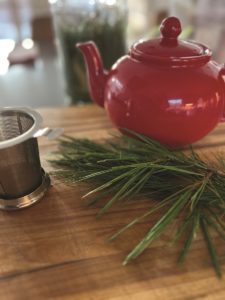My friend Ingrid Bratberg knows all the best places to find stinging nettles, wild onions, blackberries, and elderflowers. Ingrid’s a professional baker by day — her shortbread is legendary — but I think of her as my own personal herbalist. She’s always decocting or brewing or sprouting something in her kitchen.

Whenever she recounts one of her foraging forays and the medicinal tisanes that she makes afterwards, I am reminded of the character Almira Todd in Sarah Orne Jewett’s novel The Country of the Pointed Firs. She brings to mind Almira standing in her unruly “physick garden” or tending to her “rustic pharmacopoeia” with its “strange and pungent odors.”
When one of us is under the weather, Ingrid is the one to bring us a little elderberry syrup or an herb tea.
Every walk with Ingrid in the Truro woods is an education; the wild places are her larder and medicine chest. “See that,” she says. “That’s stinging nettle.” She’s not pointing it out simply to avoid our getting stung. Ingrid wants to pick some for dinner. I learned early in our friendship that that stinging nettle, properly prepared, makes a delicious soup that’s the most astonishing shade of green. And so it goes when she points out lamb’s quarters, elderberry, wintergreen, dandelion, purslane, Japanese knotweed, and beach peas.
Christopher and I are trying to embrace, rather than resist, the winter darkness now that we’re in Truro year-round. So, I asked Ingrid to recommend a natural tonic with which to toast the darkness of the solstice and salute the new year. I wanted something restorative to follow the excesses of the holidays, and she suggested a simple tea made with the new needles of the eastern white pine tree. The tea, she said, is packed with vitamins A and C as well as flavonoids, which are thought to reduce inflammation.

“It’s like drinking the forest in winter,” she added.
We set out on a crisp, bright morning to a lush stand of white pines just off North Pamet Road.
The tree is easy to identify by the size and shape of its needles, which are straight, slender, and a light bluish-green. The soft, flexible needles measure anywhere from two to six inches long, are three-sided, and grow in little clusters — fascicles — of five. Our plan is to gather enough branch tips for a pot when we get home and for a big jar to leave out to steep in the sun. Once strained, the tea will keep either outside or in the refrigerator for a week, ready to be heated up as needed.
As we gather the needles in silence, I remember my last foraging expedition, a search for mushrooms in September with my friend Vida. We started at one of her favorite spots near Head of the Meadow. It was a cold, damp day, and we saw only one other person hunting mushrooms. We picked enough for a meal for each of us and then headed to Vida’s other favorite spot, Provincetown’s Beech Forest. There we saw scores of cars and SUVs lining the road. Open trunks were filled with enormous trays and boxes of just-picked mushrooms. The woods had been picked clean.
I have been worrying ever since that sharing the experience of foraging could lead to the ruination of our wild places. While white pines do not seem to be in danger from human activities here (there are some fungal diseases working against them in some places, though), Ingrid worries about over-foraging, too, so we are mindful of how much we take, listening to Indigenous ecologist Robin Wall Kimmerer, who, in her book Braiding Sweetgrass, calls for foraging with an eye to an “honorable harvest” — taking just what’s needed and leaving enough for nature to use to replenish and restore.

Back at home I strip the needles from the branches and give then a vigorous rinse to remove any critters that might call them home. Next, I cut the needles roughly in half, which aids in flavor extraction. I try various methods but find that holding a small bundle of needles in one hand and cutting them with kitchen shears is the most efficient.
Ingrid recommends three or four tablespoons of chopped needles for a large mug of well-flavored tea. My teapot holds about three large mugs, so in go 12 tablespoons of chopped needles followed by boiling water. The needles need to steep for quite a while longer than I expected for good flavor. I taste every few minutes, but I think at least 20 minutes are required for full flavor. By then I have to reheat the tea in the microwave, which is why Ingrid suggested making the large crock.
The tea has a mild pine and citrus flavor and smells a bit like rosemary. It also suggests mint, and next time perhaps I’ll add some leaves to heighten that flavor. Sweetened with honey from our hive, the tea was exactly what I wanted to warm myself as the early shadows of the winter afternoon lengthened. I only wished I had some of Ingrid’s shortbread, too.
Note: We cannot find specific studies about eastern white pine needle toxicity, but just in case, white pine needle tea should be avoided by those who are pregnant or nursing.



